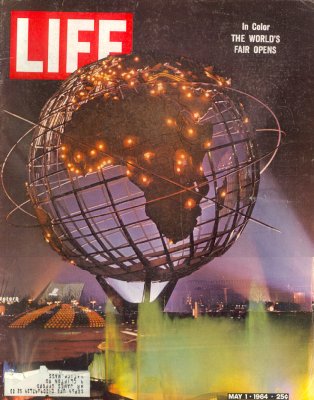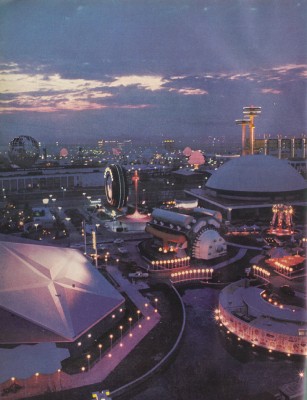COVER Double-exposure
taken at twilight superimposes the World's Fair's fountains in
front of the exposition's symbol, the Unisphere.
 |
-
THE SHOW GOES ON,
-
THE SPOILERS LOSE
THE DAY
|
Isaiah Brunson, that angry young man, made
his promise plain -- and everyone believed. "We're going
to block every street that can get you anywhere near the World's
Fair -- and give New York the biggest traffic jam it's ever had."
As that gaudy, gay affair in Flushing Meadow prepared to open,
a gloomy sense of apprehension settled over the city. Civic leaders,
the mayor, even the President of the United States took Brunson
seriously.
But when the time came, Brunson could not
produce. He fell so short of producing that his effort was a
little ludicrous and a little sad.
The New York World's Fair opened almost without
a hitch. Instead of the 2,000 stalled cars Brunson had promised,
there were but a handful and they were quickly hauled out of
the way. A brief try to jam the subways -- an auxiliary Brunson
plan -- was broken in one sharp, early morning encounter with
the police. That ended it. The Fair opened, the bands played,
the dignitaries came and went ...
Brunson is a restless, inarticulate bear of
a man who is chairman of the Brooklyn CORE chapter. When the
Fair neared completion, all candy-bright and gay in a world that
is in fact harsh, some demonstration seemed natural -- even automatic
-- to Brunson.
So he hit upon and announced the traffic jam.
And it might have connected. When Shea Stadium opened a week
before the Fair, a simple ball game snarled traffic for hours
on the expressways that lead to the Fair. Brunson expected that
2,000 cars would be available. But there was no coordination.
It was up to each volunteer to pick the time and the place where
he would stall - and to deal afterward with the police on his
own. Even the people who were supposed to tie up the subway had
not yet decided what they would do or where they would do it.
The police, along with the rest of the city,
confused the intensity of Brunson's cause, which is real, with
the extent of his organization, which is ephemeral. As a result,
the police were organized. They had been rehearsing techniques
for dealing with Brunson. Long lines of wreckers waited beside
the expressways. A helicopter, capable of lifting cars from the
roadway, stood ready. Police on foot were posted at regular close
intervals along the expressways, ready to pounce on anyone who
paused.
When trouble came -- and there were far fewer
incidents than anyone had expected -- the police moved swiftly.
When demonstrators tried to block a train at a subway station,
a platoon of cops swept in and broke it up in a club-swinging
encounter that left several demonstrators and one officer injured.
An attempt to block the Triborough Bridge was stopped.
And in their way, the people of New York were
organized too. They simply stayed away, not only from the Fair
(most of the visitors were tourists) but from the expressways
that passed it. Traffic was 25% of normal and only a tiny fraction
of what might be expected on the day a world's fair opens.
Everyone, in other words, was organized for
the attack except the attackers. They -- the few who actually
participated -- started out under the cold and drizzling skies
and found the expressways nearly deserted. Those who stalled
did so under the watchful eyes of a nearby cop. Only a handful
bothered.
by DAVID NEVIN
SOURCE: Life Magazine,
Vol. 58 No. 18, May 1, 1964, excerpted
|
"In a blaze of color,
and to the shiver of excitement that man always feels when he
looks into his past and his future, the New York World's Fair
last week opened its gates. It is a whopping show -- the biggest
fair ever -- that transports the visitor forward to the pipe
dream when man may somehow tame the deserts and live beneath
the oceans. It is a look backward, awesome and nostalgic, at
the distance he has traveled since he lived in caves, and at
wondrous things he has done along the way. It is a potpourri
of his artistic genius through all the years -- and it has a
Dead Sea Scroll and the Pieta.
A miniature Tutankhamen lies in a golden coffin just across the
street from the latest Japanese motorcycle. It is a banquet table,
stacked with delicacies from Korean kimchi to French cuisine
to pizza. It is an intimate circus, a universal classroom and
a cultural bazaar, where the pagodas and minarets of the ancient
East stand side by side with the towers of the modern West. And,
like all good fairs, it has a frosting of sky rides and hot dogs
and music."
Life Magazine, May 1, 1964
Only five years had passed since five men
met at City Hall to discuss an idea that New York should host
another World's Fair. Those years had been filled with triumphs
and failures for the Fair. All of that was history now. The Fair
opened, on time, as promised. Life Magazine, in its
cover story of the Fair's opening, called it "A Smasheroo
of a World's Fair." It was that, and more.
Opening Day, April 22, 1964, dawned grey,
cold and rainy. A planned "stall-in" by civil rights
demonstrators had the city on edge. People stayed home. Over
the next two years, the Mighty Fair would struggle to triumph
over failure: Poor attendance. Financial difficulties. Criticism
over high prices, banal exhibits and gross mismanagement. The
failures have too often been the story of the Fair.
To the millions who would visit, the Fair
would be an experience of a lifetime. The organizers, planners,
managers, tradesmen, designers, architects, engineers, craftsmen
and artisans who had brought about this "Miracle in the
Meadow" are the true story of the Fair. This feature at
nywf64.com is dedicated to them.
DAWN AT THE FAIR. Light from east
falls upon illuminated outlines of Chrysler Pavilion, (foreground),
U.S. Rubber's Ferris Wheel (center) and the Unisphere (left
rear).
|

SOURCE: Life Magazine,
Vol. 58 No. 18, May 1, 1964
|
|